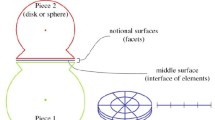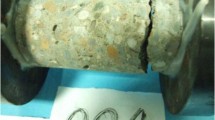In this study, pre-cracked cubic specimens of concrete materials were especially prepared in a concrete laboratory to study the breaking process of brittle solids. Then, the linear elastic fracture mechanics concept of the stress intensity factor and the experimental methods were used to investigate the failure mechanism of pre-cracked concrete specimens under compression. The crack propagation mechanism and the ultimate strengths of these specimens were obtained in the laboratory. Several numerical analyses were also carried out on the pre-cracked specimens, using the finite element method and ABAQUS software package. The damage location and convergence diagram of the differential evolutionary algorithm under mode I, II, III or IV loading conditions were investigated for the cubic pre-cracked concrete specimens containing a single center crack with different inclination angles. The crack propagation mechanisms obtained numerically were compared with the corresponding experimental ones proving the proposed method’s feasibility.















Similar content being viewed by others
References
T. Vo-Duy, V. Ho-Huu, H. Dang-Trung, et al., “Damage detection in laminated composite plates using modal strain energy and improved differential evolution algorithm,” Procedia Engineer., 142, 182–189 (2016).
Z. H. Ding, M. Huang, and Z. R. Lu, “Structural damage detection using artificial bee colony algorithm with hybrid search strategy,” Swarm Evol. Comput., 28, 1–13 (2016).
A. Kaveh, S. R. Hoseini Vaez, and P. Hosseini, “Enhanced vibrating particles system algorithm for damage identification of truss structures,” Sci. Iran., 26, No. 1, 246–256 (2019).
G. F. Gomes, Y. A. D. Mendéz, S. S. da Cunha, and A. C. Ancelotti, “A numerical–experimental study for structural damage detection in CFRP plates using remote vibration measurements,” J. Civil Struct. Health Monit., 8, No. 1, 33–47 (2018).
A. Benedetti, G. Pignagnoli, and M. Tarozzi, “Damage identification of cracked reinforced concrete beams through frequency shift,” Mater. Struct., 51, 147 (2018), https://doi.org/10.1617/s11527-018-1275-z.
D. Dinh-Cong, T. Vo-Duy, V. Ho-Huu, et al., “An efficient multi-stage optimization approach for damage detection in plate structures,” Adv. Eng. Softw., 112, 76–87 (2017).
M. F. Marji, H. Hosseini-Nasab, and A. H. Kohsary, “A new cubic element formulation of the displacement discontinuity method using three special crack tip elements for crack analysis,” JP J. Solids Struct., 1, No. 1, 61–91 (2007).
M. Fontan, A. Ndiaye, D. Breysse, et al., “Soil–structure interaction: Parameters identification using particle swarm optimization,” Comput. Struct., 89, Nos. 17–18, 1602–1614 (2011).
H. Haeri and M. F. Marji, “Simulating the crack propagation and cracks coalescence underneath TBM disc cutters,” Arab. J. Geosci., 9, No. 2, 124 (2016).
O. Abdeljaber, S. Avci, M. Kiranyaz, et al., “Real-time vibration-based structural damage detection using one-dimensional convolutional neural networks,” J. Sound Vib., 388, 154–170 (2017).
V. Sarfarazi, H. Haeri, M. F. Marji, and Z. Zhu, “Fracture mechanism of Brazilian discs with multiple parallel notches using PFC2D,” Period. Polytech.-Civ., 61, No. 4, 653–663 (2017).
S. R. H. Vaez and N. Fallah, “Damage identification of a 2D frame structure using two-stage approach,” J. Mech. Sci. Technol., 32, No. 3, 1125–1133 (2018).
K. Samir, B. Brahim, R. Capozucca, and M. A. Wahab, “Damage detection in CFRP composite beams based on vibration analysis using proper orthogonal decomposition method with radial basis functions and cuckoo search algorithm,” Compos. Struct., 187, 344–353 (2018).
D. Dinh-Cong, S. Pham-Duy, and T. Nguyen-Thoi, “Damage detection of 2D frame structures using incomplete measurements by optimization procedure and model reduction,” J. Adv. Eng. Comput., 2, No. 3, 164–173 (2018).
D. Dinh-Cong, H. Dang-Trung, and T. Nguyen-Thoi, “An efficient approach for optimal sensor placement and damage identification in laminated composite structures,” Adv. Eng. Softw., 119, 48–59 (2018).
S. Bureerat and N. Pholdee, “Adaptive sine cosine algorithm integrated with differential evolution for structural damage detection,” in: Proc. of the 17th Int. Conf. on Computational Science and Its Applications, Springer, Cham (2017), pp. 71–86.
N. Fallah, S. R. H. Vaez, and A. Mohammadzadeh, “Multi-damage identification of large-scale truss structures using a two-step approach,” J. Build. Eng., 19, 494–505 (2018).
H. D. Hibbitt, B. I. Karlsson, and E. P. Sorensen, ABAQUS User’s Manual, Dassault Systèmes Simulia Corp., Providence, RI (2012)
Author information
Authors and Affiliations
Corresponding author
Additional information
Translated from Problemy Prochnosti, No. 5, pp. 98 – 110, September – October, 2021.
Rights and permissions
About this article
Cite this article
Fu, J., Haeri, H., Yavari, M.D. et al. A Linear Elastic Fracture Mechanics Analysis of the Pre-Cracked Concrete Failure Mechanism Under Modes I, II, III, and IV Loading Conditions. Strength Mater 53, 784–796 (2021). https://doi.org/10.1007/s11223-021-00344-5
Received:
Published:
Issue Date:
DOI: https://doi.org/10.1007/s11223-021-00344-5




